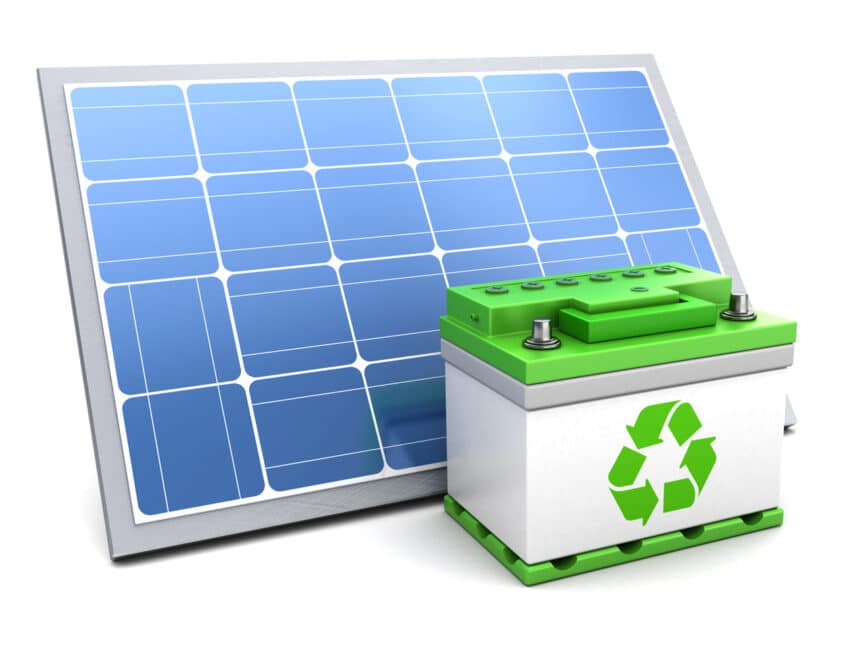Although solar panels are the visible parts of solar energy systems and receive by far the most attention, the humble solar battery is poised to play an equally prominent role in the solar power world. Because solar batteries maximize the use of the power generated by solar systems, they have a pronounced effect on bringing down electricity bills and reducing dependence on public energy grids.
This not only provides an added financial benefit for solar system owners, it also will increasingly relieve pressure on public grids, contributing further to the clean energy revolution.
What Is A Solar Battery?
A solar battery is a battery designed specifically to store electricity produced by solar panels and to make that power available for later use. A solar battery can be used in several situations:
- A small solar installation, typically a house with a solar energy system
- A slightly larger installation, say a business with a larger system and several batteries, or
- In a large group of solar batteries at a solar energy generating plant.
In addition, solar batteries are used in the growing number of standalone solar charger units being installed in cities, for example to provide mobile phone and tablet charging facilities for the public.
How Does A Solar Battery Work?
A solar battery takes in electricity from solar panels. Any electricity that isn’t used immediately is stored for later use. The solar battery (more typically, a set of solar batteries in a combined solar storage unit) consists of solar batteries and a controller unit to monitor and control electricity input and output levels.
What Is the Big Idea of Having A Solar Battery (or Group of Solar Batteries)?
Solar energy is a significant source of clean, renewable and sustainable energy. However, solar energy systems without associated battery storage have several key limitations:
- Solar power systems can only produce electricity during daylight hours
- Even during daylight hours, the amount of energy produced will vary in proportion to the amount and strength of the sunlight landing on the solar panels
- At any given point, the maximum amount of electricity that can be drawn from a solar power system is the amount of power that the system is producing at that moment; any further electricity requirements will have to be met by an alternative source
- On the other hand, all electricity produced by a solar energy system must be used in real-time or it goes to waste (again, where a battery system is not in place)
- The bottom line is that while solar power is a superb solution, in its basic form, without battery storage, it cannot provide power 24X7, nor meet any peak demands that exceed its maximum electricity generating capacity at a given moment.
In solar energy systems used by homes and small businesses, these limitations undermine the benefits of the system to a degree, compared what a battery storage solution would enable. As a result, the owner of the home or business would save less on their electricity costs, because they would have to use electricity from the grid more than if they were able to store electricity in batteries for later use.
In the case of electricity utilities, however, the problem becomes even more dramatic:
In the summer of 2016, the California natural gas storage facility at Aliso Canyon outside Los Angeles suffered a massive leak. Since this natural gas is used by neighboring power plants to generate electricity, this posed a serious issue for the region, with electricity shortages and black-outs predicted if a solution could not be found quickly.
More broadly, this pointed to a more strategic issue of power plants having a finite ability to increase production to cope with spikes in demand or unpredicted significant shortfalls. The solution to the Aliso Canyon crisis was to rapidly commission and construct three large-scale solar battery storage facilities nearby. These accounted for 15% of the worldwide installation of solar battery storage in 2016. (As a side note, this emergency measure was completed within just six months, a feat that by normal standards would have taken years. And notably, Tesla’s facility was completed in a mere six weeks.)
This story illustrates the invaluable benefits of a solar battery installation:
- It captures any electricity produced by a solar energy system that is not used in real-time, thus generating more savings on electricity costs
- It provides electricity at the highest rate the solar battery can deliver, regardless of the rate of electricity being generated by the solar energy system at any point
- Subject to how much electricity each solar battery has within it, the battery (or group of batteries) can meet any extra demands that occur either from usage patterns or a shortfall elsewhere in the local grid
Moving away from utility-scale solar energy generation, solar batter benefits are also very positive for solar energy systems in residential and business settings. Exciting examples of solar batteries in these uses include standalone chargers for ebikes and solar power generation units for public spaces.
Things to Know Before Buying a Solar Battery
Types of Solar Batteries
Solar batteries currently come in two types:
- Lead acid – These are cheaper, but provide lower performance and shorter life
- NiCad – These cost more, in exchange for far better performance and longer life
Solar Battery Life
Solar batteries carry warranties on the number of ‘cycles’ they will deliver. One cycle is defined as one complete discharge of the battery (using it until its store of electricity is empty) followed by a full recharge. In practice, a solar battery is most likely to normally be partially discharged then recharged, rather than get fully discharged each time. The range of lifetimes for leading solar batteries varies significantly, but will be in the thousands of cycles, say between 2,000-10,000 cycles (although solar battery technology is improving constantly and at a fast rate).
Solar Battery Capacity Ratings
In a similar fashion, solar batteries come in a variety of capacity ratings, which refers to the maximum amount of electricity they can hold at any one time. Current batteries range from just over 1 kilowatt (kw) to 10kw. However, an important distinction to be aware of is the vital difference between maximum capacity and ‘usable’ capacity. This is because a solar battery should never be drained completely. Therefore, it is important to know whether a solar battery’s stated capacity is the usable or maximum amount.
The Future for Solar Batteries
Solar batteries are already big business, and they are set to become a massive factor in the growth of solar energy in the coming years. This is because they are such a robust means of providing electricity when solar systems are not generating electricity, or even working in the background during daylight hours. As a result of maximizing the use of the power generated by solar systems, they have a pronounced effect on bringing down electricity bills and reducing dependence on public energy grids. This in turn relieves pressure on public grids, which will make it easier to meet growing electricity needs in a sustainable manner.
Key references for this article:
Bildquellen
- Ein PV Modul und eine Batterie: Mmaxer | Shutterstock.com



